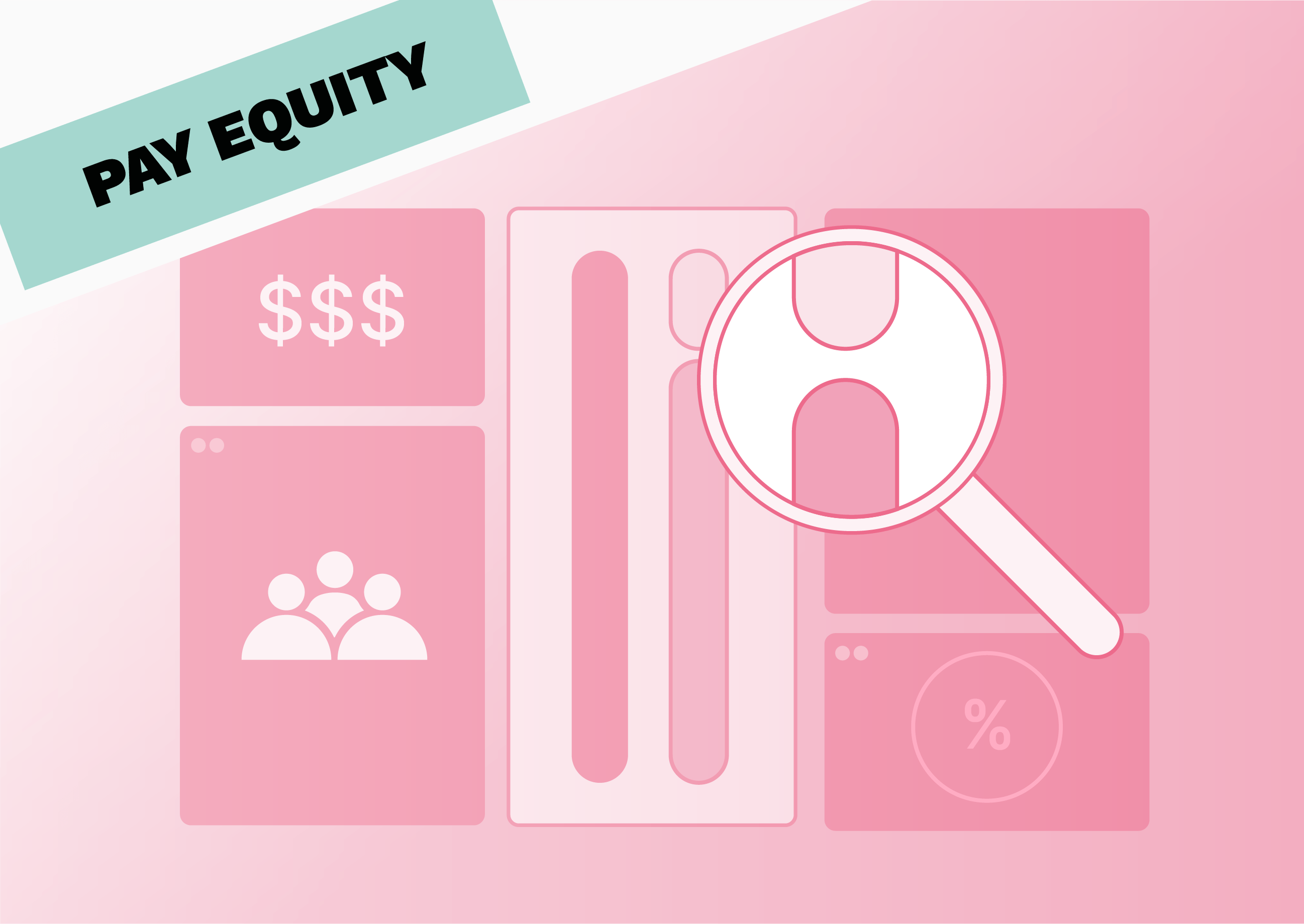Key points:
- Pay equity drives measurable business results: Companies with effective pay equity are 1.6 times more likely to meet financial targets and see 45% lower turnover risk.
- Manual analysis fails when it matters most: Traditional spreadsheet-based pay equity reviews take 8+ weeks to complete and are outdated by publication.
- Most companies exceed compliance thresholds: 82% of European companies already have pay gaps above the EU's 5% trigger point for mandatory action.
The simple fact is that employees want to know they’re being paid fairly. And these employees won’t need to be told what fair pay for their positions is; they’ll likely already know.
That’s because three-quarters of employees (74%) conduct research about fair pay before applying for a new job, preparing for a performance review, or asking for a raise. That senior developer you’ve seen browsing Glassdoor? Yeah, they’re not doing that for fun. They’re building a case for their next conversation with you.
It's worth ensuring those numbers align, because employees who discover pay disparities rarely stay quiet about it. If you’re lucky, the employee might go straight to HR to try to resolve the situation. If not, they’ll be searching for a fairer paying job quicker than you can say “Wait! We’ll try to find room in the budget!”
And if you’ve been particularly unfair, you could face legal action. With the EU Pay Transparency Directive, employees have a right to compensation if they’ve suffered discriminatory pay. Alongside paying compensation, your business will likely face sanctions, too.
That’s why it’s crucial to perform regular pay equity analyses. And not just because you want to be square with the EU, but because it can bring a tonne of benefits to your business as well. And we’re going to show you exactly what those benefits are. This guide will help you move from defensive compliance to proactive equity.
What is pay equity?

Illustration showing the difference between equality and equity
Pay equity is equal compensation for work of equal value, regardless of gender, ethnicity, or other protected characteristics. This includes not just base salary, but bonuses, benefits, stock options, and advancement opportunities.
Sounds straightforward, right? We’d like to think so too, yet most organisations still manage to confuse equity with equality. And that distinction matters enormously for both compliance and fairness. So what’s the difference?
Well, equity focuses on fairness at the role level. It means two software engineers with similar experience and performance receive comparable total compensation packages.
Equality, on the other hand, examines average pay across demographic groups at the organisational level. For example, it looks at whether women earn the same average salary as men across the entire company.
Here’s where it gets interesting: you can have perfect pay equity yet still have pay inequality.
For instance, consider that all engineers at the same level earn identical salaries (perfect equity), but women represent only 15% of senior engineering roles while making up 60% of junior positions. The average female engineer earns less than the average male engineer (pay inequality), even though no individual woman is underpaid for her specific role.
That’s why it’s crucial you identify the difference between pay equity and pay gaps, because the solutions are entirely different. Equity issues require salary adjustments. Inequality issues require promotion and hiring strategy changes.
The hidden complexity: justified vs. unjustified differences
Before we move on, understand that not all pay differences signal discrimination. Some reflect legitimate business decisions, while others expose unconscious bias or outdated practices. Distinguishing between the two can be a real head-scratcher, however.
Let’s make it a little easier to determine if pay differences are justified:
✅ Legitimate (justified) factors:
- Performance: Consistently exceeds targets vs. meets expectations.
- Experience/tenure: 10 years in role vs. 2 years.
- Specialised skills: Speaks Mandarin for Asian market expansion.
- Location: Munich vs. Madrid cost of living adjustments (must be consistent with existing region bands and indexes).
- Education/certifications: Advanced degree directly relevant to role.
- Scope of responsibility: Manages 20 people vs. 5.
- Market conditions: Hired during a talent shortage vs. the employer's market (must keep evidence of market scarcity and failure to hire at lower rates).
❌ Red flag (unjustified) factors:
- Negotiation differences: “He asked for more” isn’t a valid business reason.
- Previous salary: Perpetuates historical inequities.
- “Potential”: Often masks unconscious bias.
- “Culture fit”: Frequently discriminatory.
- Part-time status: The hourly rate should be equivalent.
- Family status: “He has a family to support” is illegal discrimination.
💡 Why this matters: In companies with 150+ employees, you’re making thousands of these judgment calls annually. Manually reviewing every pay decision is impossible. This is where pay equity software becomes essential.
The difference between a well-documented pay structure and potential compliance issues often comes down to clear documentation. Can you explain, with data, why Sarah earns 15% more than James? If the answer involves performance metrics, additional qualifications, or expanded responsibilities – excellent. If it’s because “she negotiated better,” well… we wish you luck justifying that in front of a tribunal.
The benefits of pay equity in the workplace
So now you understand these distinctions, what do you get in return for actually getting pay equity right?
Quite a lot as it turns out. And it’s not just the warm fuzzy feeling you get when you’ve done something good. Take a look.
Compliance and risk mitigation
The EU Pay Transparency Directive takes effect in 2026, changing how European companies manage compensation. Under these regulations, pay gaps of 5% or more trigger mandatory Joint Pay Assessments for companies with 250+ employees.
The 250+ employees mark is mandatory across the EU. But some countries have set those requirements at lower numbers. For instance, France starts this requirement at just 50+ employees… talk about getting ahead of the curve!
So why should this matter to you? Well, identifying disparities now prevents costly remediation later. That’s easier said than done, though, especially if you have to sort through tonnes of spreadsheets and work out complex sums yourself.
That’s where you need a tool like Figures. Professional pay equity analysis can spot problematic gaps months before they compound, turning what could become expensive corrections into manageable adjustments. You’ll never have to crunch a number or write a complicated formula again. Save the writing for your memoirs instead.
The cost of non-compliance extends far beyond regulatory fines. Legal settlements for pay discrimination can reach hundreds of thousands of euros, while brand damage from public pay gap disclosures affects recruitment costs for years.
Take Disney, for instance, the happiest place on Earth… for men at least. They recently settled a lawsuit for $43 million regarding systemic underpayment of women at the corporation. That’s not even accounting for the legal costs of a case that’s been going on since 2019, or the damage to their reputation following the settlement.
All we can say is, we hope Minnie Mouse starts getting paid as much as her on-screen boyfriend.
Retention and talent acquisition
Moving on, 60% of candidates choose employers based on values alignment, with fair pay being a fundamental consideration.
That means proactive compliance becomes a talent magnet. Companies that transparently address pay equity before regulations force their hand attract candidates who value integrity and forward-thinking leadership.
Even if you don’t believe in transparency, your employees (and future prospects) absolutely do. We can see that with platforms like Glassdoor, where every detail about your company will be bared for the world to see, including your pay equity practices.
This also ties in to how pay equity impacts retention.
Considering that you could pay anywhere between $2500-$25,000 for talent acquisition, you’ll need to pull out all the stops to ensure that your employees stay put. Pay equity is one way to do this, especially when you consider that employees who believe they’re paid unfairly are 45% more likely to look for a new role.
Performance and profitability
Employees who perceive pay disparities show 13% lower engagement. Underpaid employees spend work hours job hunting, not performing. So when you see that ‘Open To Work’ banner on their LinkedIn profile picture, don’t be surprised!
The numbers truly speak for themselves: only 5% of companies have effective pay equity, but those that do are 1.6 times more likely to meet or exceed financial targets.
If that’s not enough of an incentive, let’s look at the flipside. Pay gaps drain performance through turnover, legal settlements, and missed revenue targets when key performers leave for competitors offering fair compensation.
💡Pro tip: A 10% pay gap doesn’t cost 10% to fix. It compounds through lost talent, innovation drain, and damage to reputation.
How pay equity tools uncover and correct hidden disparities
Conducting a pay equity analysis can be difficult. Especially if you’re using outdated methods.
Spreadsheets take months to compile, contain errors that undermine credibility, and are outdated by the time you present findings to leadership. Meanwhile, the gaps you're trying to measure continue widening.
That’s why you need pay equity software like Figures that’ll help you sort through the mess:
- Eliminates months-long manual processes – Automated data ingestion from 30+ HRIS systems delivers analysis instantly, not 8 weeks.
- Real-time gap monitoring – Shows when your engineering team’s gap crosses 5% today, not during December’s annual audit, catching problems before employees resign.
- Distinguishes justified from unjustified gaps – Displays both adjusted and unadjusted disparities, helping you determine whether differences reflect legitimate factors (performance, experience) or hidden bias.
- Granular drill-down capability – Navigate from company-wide overview → department analysis → individual employee assessment to target remediation budgets effectively.
- Comprehensive audit trail – Documents gap identification and correction progress for EU compliance requirements.
- Comprehensive compliance reporting – Documents gap identification and correction progress with exportable reports specifically designed to meet legal requirements and regulatory inquiries for EU compliance.
- Contextual gap and remediation – Most tools find disparities; Figures determines which ones actually matter and provides budget-based recommendations for correction. Once you've identified problematic gaps, you receive contextual recommendations tailored to your compensation review budget, then take corrective action directly within the platform to move towards greater equity.
Transform reactive damage control into proactive gap prevention, with continuous monitoring that catches new disparities before they become a real problem.
"Figures helped us build a full salary transparency structure, making it easier to transition into an open, fair compensation model," shares Emma Herrero from Phiture.
Reap the rewards of workplace pay equity
The benefits are clear: companies that get pay equity right see 1.6x better financial performance, 45% lower turnover risk, and 13% higher engagement compared to those that don’t.
Keep in mind, pay equity doesn’t mean you have to obsess over achieving mathematical perfection across every salary. Instead, just focus on investigating which differences are justified (skills, tenure, performance) and fixing those that aren’t (bias, historical inequities, negotiation disparities).
With 82% of companies exceeding the EU’s 5% threshold, the question isn’t if you need to act, but how quickly you can transform compliance into a competitive advantage. The organisations moving first will attract better talent while their competitors scramble to meet regulatory requirements.
Of course, you’ll need the right software that can help you attain that competitive advantage.
Figures helps you find gaps AND determine which ones matter. Real-time monitoring catches problems early, adjusted analysis distinguishes bias from legitimate differences, and clear decision support guides remediation priorities.
The companies winning the talent war treat fair compensation as competitive intelligence, not regulatory overhead. Book a free demo today and discover how data-driven pay equity analysis transforms good intentions into measurable results.
Summarize this article with AI
No time to read it all? Get a clear, structured, and actionable summary in one click.






